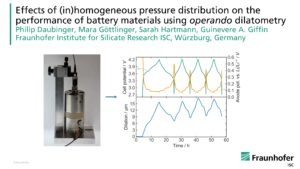Summary:
A current strategy to increase the energy density of lithium-ion battery (LIB) cells is to use thicker electrodes. Furthermore, the space within the confinements of the cell housing is utilized as much as possible for the active components. In the future, next generation anode materials, e.g. lithium metal or silicon, are to be used in order to achieve the energy targets. These next generation materials are prone to large volume changes during formation and cycling, e.g. theoretically up to ~300% for silicon and ~4.9 µm per mAh cm-2 for lithium metal [1]. This leads to a pressure build-up within the cells due to reversible and irreversible volume changes, especially of the anode materials, during cycling. The optimized packing for the state-of-the-art (SoA) electrodes and the volume changes of the next generation electrodes result in increased electrochemical/mechanical interactions building up stress inside the cells. These interactions favor aging phenomena such as lithium plating which in the worst-case can lead to internal short circuits [2].
In this work, the interactions between (in)homogeneous mechanical pressure on the cell and volume expansion are studied for SoA and next generation materials. The influence of the volume changes, primarily of the anode, on the electrochemical processes occurring in the cell is investigated using a dilation sensitive test set-up, which contains a reference electrode that allows the anode and cathode potentials to be distinguished [3].
During initial investigations of graphite vs. NCM 111, an irreversible thickness change of 8% occurs in the first cycle (Slide 3) due to solid electrolyte interphase (SEI) formation, particle rearrangement and graphene layer spacing in the graphite anode. In the following cycles, the irreversible swelling decreases and a reversible thickness change between 8% and 10% is observed. Moreover, inhomogeneous pressure distribution as well as high applied pressures accelerate aging of the electrodes significantly (Slide 4). During CCCV charging, the anode potential drops below 0 V, causing lithium plating at a lower state of charge for the inhomogeneous pressure distribution compared to the homogeneous pressure distribution due to localized exchange currents. This results in a reduction of the capacity.
Additionally, the reversible dilations of different electrode materials are shown in slides 5-7. Graphite is the main driver of the reversible electrode stack dilation in today’s LIBs, whereas NCM111 and LTO have negligible dilation. The dilation of silicon is highly dependent on pressure [4], but also on electrode porosity and other cell components. The relatively small dilation of the silicon-containing cells can be explained with the high porosity of the electrodes themselves and because of the glass fiber separator. In contrast, lithium metal shows a strong dilation during cycling. The dilation of 6.0-7.0 µm per mAh cm-2 can be explained with lithium stripping/plating and the reaction of the carbonate-based electrolyte with lithium metal.
References:
[1] D. Lin, Y. Liu, Y. Cui, Nature nanotechnology 12(3) (2017) 194.
[2] F. Ebert, A. Oberbauer, M. A. Cabañero, G. Sextl, M. Lienkamp, International Journal of Automotive Engineering, 10(2) (2019) 242-248.
[3] P. Daubinger, F. Ebert, S. Hartmann, G. A. Giffin (2021), Journal of Power Sources, 488, 229457
[4] M. Göttlinger, P. Daubinger, S. Hartmann, G. A. Giffin (2021), Manuscript in preparation.
We are happy to forward your request / feedback.

